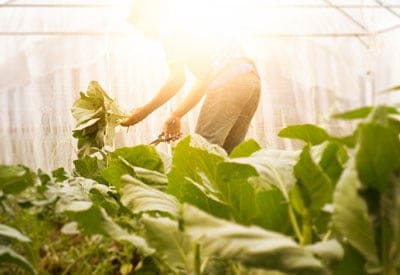So, you want to grow year round? Or maybe extend your gardening season? Interested in growing plants that normally don’t survive in your neck of the woods? If the answer to any of these questions is “yes,” then a greenhouse might be for you.
Hobby Greenhouses
A backyard greenhouse kit can provide a stable, warm environment where plants can be grown all year. They can also be used to get a jump start on the growing season, where plants, like tomatoes and peppers, are planted early and later moved out to the garden. Whatever your reason for wanting a greenhouse, there are several types, styles and costs for almost anyone who wants to start gardening under glass — or polycarbonate, for that matter!

FREE SHIPPING!
Solexx Conservatory
With the tall 9 ft. 6 in. center height, seedlings to large plants can easily be grown.
Learn moreGrowing under cover requires a bit of specialized gear, but don’t worry. At Planet Natural we know what you need. From nursery pots and seed starting supplies to grow lights and plant supports, we have what you’re looking for!
Getting Started
The first thing to figure out when buying or building a greenhouse is how much growing space you will need. Keep in mind, that a greenhouse is a long-term investment. Your selection should be large enough to provide ample room for years to come. In many instances, greenhouse owners end up wanting more square footage than they originally thought. In addition, if you plan to grow vegetables, you’ll want maximum light and plenty of headroom, which is also good for hanging plants.
There are greenhouse kits available for just about any budget, and most (even if you aren’t handy with a hammer) can be built in less than a day. Below is a quick overview of the various styles available:
Attached. The big advantage with an attached or lean-to greenhouse is that you don’t need to build all four walls. Plus, you’ll have at least one sturdy, weight-bearing wall in place (usually your house or garage), so the three greenhouse sides can be built lighter. These structures are often less expensive than other greenhouse models and are good for growing herbs, seedlings, and some vegetables in places where space is at a premium. The disadvantage is, of course, that sunlight will be limited to only three sides.
Freestanding. Freestanding greenhouses, of course, stand alone, which lets you place them wherever you want on your property (as long as the site is level and receives plenty of light). While initially more expensive than an attached greenhouse, they provide a lower cost per plant, since so many more plants can be grown in them.
In most areas across the country, a freestanding greenhouse will allow you to start plants much earlier in the growing season (January or February) and then, at first sign of frost, you can bring your plants in again to extend the growing season through October or November. Here in Montana, a separate heating system is required for year-round operation. Learn more about heating a greenhouse below.
Freestanding greenhouses have the added advantage of being a sanctuary away from home. A relaxing place that you can go to get away for awhile. A place where no phones exist and you are surrounded only by the beauty of the flowers and plants that you are growing.
Glazing
Glazing is the covering around your greenhouse frame. It is responsible for letting sunlight and its warmth in while keeping the elements out. Glass is the best glazing material, but it is also the most expensive. Plastic sheeting works well and is inexpensive (see How to build a cheap and easy greenhouse), but will deteriorate quickly. Polycarbonate is less expensive than glass, is lightweight, and retains heat better than both glass or plastic. Additionally, polycarbonate can be used on flat or bent surfaces, transmits light well, and is extremely strong.
Site Selection
The closer to the house or garden your greenhouse is located, the more you are likely to use it. Also, consider access to electricity and water — both of which you’ll probably need.
Look for a level area with maximum exposure to the sun. If possible, find a location where the greenhouse will be getting at least 6 hours of direct sunlight per day during the winter. By orienting the greenhouse east to west, the largest side will get full southern sun exposure. If you don’t have an area with enough sun, grow lights can be added to compensate.

T5 GROW LIGHT
4-Foot Fixtures
Ideal for shelves or over bench tops -- extremely powerful with very low heat!
Learn moreHydrofarm’s best 4ft T5 Grow Light (bulbs included) is great for seedlings, cuttings, houseplants, flowers… and much more! Produces more than double the output as normal fluorescent fixtures. Ideal for shelves or over bench tops.
Deciduous trees can provide needed shade in the summer, but since they lose their leaves each fall, they allow for sunlight in the winter. Avoid selecting a greenhouse site (PDF) near coniferous trees or other objects that will cast a shadow during long winter months.
A greenhouse can be placed on almost any surface, but there should be adequate drainage. To create an ideal surface, lay a layer of landscape cloth over the area to be used — this will keep the weeds out, but allow for drainage — and cover the cloth with 3 inches of 1/4-inch gravel.
Accessories
In addition to the frame of the greenhouse, there are many accessories that can go inside. Depending on your commitment and budget, you can add shelving, automatic vents, a mist system, a heating system, a fan, a tool rack, a potting bench and the list goes on. Consider what you really need, what you’d like to have and what you have room for. At Planet Natural we can make your backyard planthouse as efficient and as easy-to-manage as can be.

Environmental Control
Heating. If you live in a cold climate you may need to insulate your greenhouse to help keep your plants toasty warm. While a lot of sun will come in during the day, an uninsulated greenhouse will cool off quickly at night. In this case, a heating system may be called for (see Greenhouse Heating Requirements).
A 220-volt circuit electric heater works well. Small gas or oil heaters designed to be installed through a masonry wall are also effective. There are also solar heaters designed specifically for greenhouses.
Radiant heat lamps hung over plants combined with soil heating cables under beds will keep most plants warm enough. Be sure the greenhouse is vented and that whatever heating system you have has an automatic shut-off.
Tip: Place rocks or barrels of water inside your greenhouse to capture the suns heat and keep plants warm during cool evenings (see Winter Growing: Heating Greenhouses).

#1 COOLING KIT
Shade Cloth
Unique lock stitch construction can be cut with scissors to fit any area.
$49.95Learn moreBeat the heat with our Sudden Shade Cooling Kit. Reduces daytime temperatures up to 15˚F while blocking the harmful infrared rays of the sun. Unique lock stitch construction can be cut with scissors to fit any area and won’t unravel. Perfect for vegetable gardens and greenhouses!
Shading. In warmer environments or when the sun is directly hitting the greenhouse, shading can keep plants from getting burned by reducing the amount of summer sunlight. Polypropylene shade cloth, roll-up screens of wood or aluminum, vinyl plastic shading, or paint-on materials can all be used to shade plants.
Ventilation. Plants can get too hot even during cold or cool weather, so good greenhouse ventilation is crucial. Vents can be hand cranked, but you’ll need to monitor temperatures closely. There are electric and temperature-sensitive hydraulic vents that automatically open and close.
Installing an oscillating fan will help keep air moving through the greenhouse and prevent many disease problems.
Pests. Keeping your greenhouse and gardening tools clean is the first step in avoiding pest problems. Check plants before bringing them into the greenhouse carefully to be sure they are bug and disease-free.
If cleanliness fails, immediately remove any plants with bugs or diseases. Spraying plant foliage with Safer® Insect Killing Soap will kill or deter many soft-bodied insect pests. Also, bring good bugs in — ladybugs, green lacewings, whitefly parasites and spider mite predators — to eat the bad bugs.











